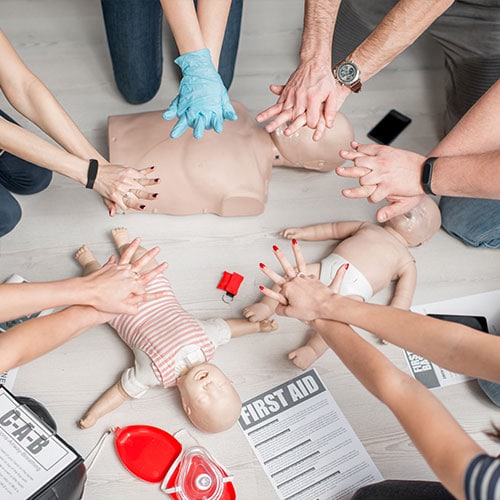Introduction
In our hectic world, emergencies can strike without warning. Whether it's a minor injury, a clinical emergency situation, or a life-threatening scenario, knowing how to provide emergency treatment can make all the distinction. This is where a First Aid course enters into play. Many people might wonder what they can gain from such training, and this short article aims to shed light on that.
By joining in a First Help and mouth-to-mouth resuscitation course, you do not simply discover bandaging wounds or performing mouth-to-mouth resuscitation; you equip yourself with important skills that might save lives. So, exactly what will you learn in a comprehensive program? Let's dive into the details.

First Help Fundamentals: What You'll Learn in an Extensive Course
Understanding First Aid
What is Very first Aid?
First aid describes the initial support offered to someone suffering from an injury or health problem until specialist medical aid shows up. It encompasses different strategies and abilities varying from straightforward wound like lifesaving methods like mouth-to-mouth resuscitation (Cardiopulmonary Resuscitation).

Importance of First Aid Training
Why Needs to You Take an Emergency Treatment Course?

Taking a First Aid course is essential for several reasons:
- Confidence: Recognizing just how to react in emergencies can instill confidence. Life-Saving Abilities: The capability to perform CPR or assist with choking can save lives. Career Development: Several professions require certification in very first aid. Community Responsibility: Learning methods you can assist others effectively.
Overview of CPR
What is CPR?
CPR, or Cardiopulmonary Resuscitation, is an emergency situation procedure carried out when someone's heart beat or breathing has stopped. It integrates upper body compressions with rescue breaths to keep blood flow and oxygenation till expert aid arrives.
The Framework of a Comprehensive Emergency Treatment Course
What Does a First Aid Course Include?
An all-round First Help and mouth-to-mouth resuscitation course usually covers the complying with subjects:
Introduction to First Aid Legal and Ethical Considerations Scene Safety Basic Life Assistance (BLS) CPR Techniques Choking Relief Wound Treatment Management Burn Treatment Managing Shock Recognizing Clinical Emergencies Using an Automated External Defibrillator (AED)Legal Elements of First Aid
Are There Legal Ramifications Involved in Giving First Aid?
Yes, providing emergency treatment does carry legal obligations referred to as "Do-gooder laws." These laws safeguard individuals that aid others in emergencies, provided their activities are sensible and not reckless.
Scene Security: The Very First Step
How Do You Ensure Scene Safety?
Ensuring scene security involves assessing the setting before coming close to the victim:
- Look for prospective risks (traffic, fire). Make certain it's safe for both you and the victim.
Basic Life Support (BLS)
What Duty Does BLS Play in Emergency Situation Situations?
Basic Life Support includes the fundamentals of maintaining life features up until more clinical assistance arrives. This area covers important skills such as:
- Checking responsiveness Activating emergency situation services Performing premium chest compressions
Advanced CPR Techniques
What Are Advanced Techniques Covered in CPR Courses?
Advanced techniques might consist of:
- Two-rescuer CPR Use of barrier gadgets for rescue breaths Special factors to consider for infants and youngsters
Choking Alleviation Techniques
How Do You Assist A Person That is Choking?
Choking relief involves 2 crucial strategies:
The Heimlich maneuver for adults. Back impacts and chest drives for infants.Wound Treatment Management
How Do You Effectively Handle Wounds?
CPR Course Sydney CBD - skillstrainingcollege.com.auEffective wound monitoring entails:
- Cleaning the wound with saline or tidy water. Applying antibiotic ointment. Covering it with sterilized dressings.
Burn Treatment
What Work Approaches for Treating Burns?
Burn treatment varies by degree:
Cool the melt under running water. Cover it with non-stick dressings. Seek medical focus for serious cases.Managing Shock
How Is Shock Acknowledged and Treated?
Recognizing shock includes searching for signs and symptoms like light skin, fast pulse, or complication:
Lay the person down. Elevate their legs unless there are injuries avoiding this. Keep them calm until help arrives.Recognizing Medical Emergencies
What Kinds of Medical Emergencies Need To You Realize Of?
Common medical emergencies consist of:
- Heart strikes Stroke Severe allergic reactions Comprehending these conditions aids you act quickly.
Using an Automated External Defibrillator (AED)
How Do You Utilize an AED Correctly?
Using an AED includes turning it on, affixing pads according to illustrations on the device, and following voice triggers carefully.
First Aid Course CabooltureImportance of Continual Learning
Why Is Continuous Learning Important in First Aid Training?
Continuous knowing ensures you remain upgraded on ideal methods and new procedures in emergency treatment care.
FAQs About Emergency treatment Courses
What Is Consisted of in a Standard First Aid Course?- A common course typically covers basic life assistance, injury administration, choking relief techniques, and legal considerations.
- Most training courses range from 6 hours to 16 hours depending on the depth of material covered.
- Yes, upon effective conclusion of most training courses, participants obtain a first aid certificate, which is typically legitimate for 2 years.
- Yes! Lots of organizations supply on the internet training courses that offer flexible knowing environments while still being effective.
- Absolutely! Hands-on technique is important for understanding abilities like upper body compressions and using AEDs effectively.
- Generally, there are no age restrictions; however, individuals have to be mentally competent to learn these life-saving abilities effectively.
Conclusion
Enrolling in an extensive first aid course furnishes people with crucial knowledge that can conserve lives throughout emergencies-- whether at home, work, or out in public rooms! From comprehending basic life support treatments like CPR to learning how to manage wounds correctly or acknowledge indications of shock-- these training courses offer invaluable training that any individual can profit from!
As we navigate with our every day lives full of unpredictability-- what better way than preparing ourselves through knowledge obtained from organized training sessions focused on saving lives?
In verdict-- if you're pondering taking up any kind of kind of first-aid training-- never think twice! Equip on your own today with these effective tools because readiness absolutely makes all the difference when every second counts!